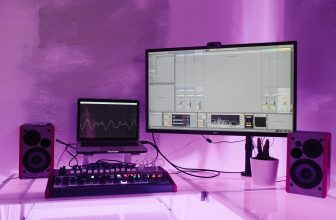
Screen recording technology has become a crucial tool in various industries, enabling professionals to capture, share, and explain content in a more interactive and dynamic way. From education and gaming to marketing and corporate communication, screen recording has found its place in everyday workflows. As technology continues to evolve, so does the functionality and application of screen recording software. In 2025 we are poised to see significant advancements that will shape the future of this tool. Let’s explore the key trends to watch in screen recording for 2025
1. AI-Powered Screen Recording
Artificial intelligence (AI) is revolutionizing numerous sectors, and screen recording is no exception. One of the most exciting trends to watch in 2025 is the integration of AI into screen recording software. AI can automate many tasks that were previously manual, improving the overall user experience.
AI Enhancements to Look Out For:
Automatic Transcriptions and Captions: Screen recording tools with AI capabilities will increasingly offer real-time transcription services, converting audio into text on the fly. This is especially valuable for accessibility and can help in creating content for a global audience by generating multilingual subtitles.
Content Recognition: AI will enable screen recording software to recognize the content being recorded and offer suggestions for enhancing the video. For example, if a tutorial is being recorded, the software might suggest annotations or chapter breaks for easier navigation.
Smart Editing: AI-based screen recorders will help users by offering automated editing options, such as removing silences, cutting unnecessary parts, or highlighting key moments.
2. Cloud Integration and Collaboration
The shift towards cloud-based solutions has transformed many industries, and screen recording is joining the movement. In 2025, screen recording software is expected to become more deeply integrated with cloud storage and collaboration platforms.
Benefits of Cloud Integration:
Instant Access to Recordings: Users will be able to record their screens and immediately upload the content to the cloud, making it accessible from any device, anywhere in the world. This is especially useful for businesses, educators, and content creators working remotely or collaborating across different locations.
Real-Time Collaboration: Cloud-based screen recording tools will allow multiple users to collaborate on the same recording project simultaneously. For instance, a marketing team might work together to edit and annotate a product demo video, or teachers could collaborate on an educational tutorial.
Seamless Sharing: Cloud integration simplifies the process of sharing recordings, making it easier to send files directly to stakeholders, embed recordings in presentations, or upload them to social media platforms.
3. Enhanced User-Friendly Features
As screen recording tools become more popular, developers are focusing on making them accessible and user-friendly. One of the key trends for 2025 is the emphasis on intuitive design and streamlined workflows.
User-Friendly Features to Expect:
Drag-and-Drop Interfaces: To make screen recording even easier, developers are likely to introduce drag-and-drop functionality for editing and managing screen recordings. This will simplify the editing process, allowing users to easily rearrange clips, add annotations, or insert transitions.
Pre-Set Recording Modes: More screen recording software will offer pre-set modes tailored to specific tasks, such as recording gaming sessions, software tutorials, or video conferences. These modes will optimize settings like resolution, frame rate, and audio capture to ensure the best possible recording for each type of content.
Built-In Tutorials and Support: With the growing demand for screen recording tools, especially among non-tech-savvy users, more platforms will include built-in tutorials and customer support options to guide users through the recording and editing process.
4. Screen Recording for AR/VR Content
Augmented Reality (AR) and Virtual Reality (VR) are on the rise, and in 2025, screen recording will evolve to support these immersive technologies. As more businesses, educators, and gamers adopt AR and VR, the demand for screen recording tools that can capture these experiences will grow.
How Screen Recording Will Adapt to AR/VR:
360-Degree Recording: Screen recording tools will begin to offer the ability to capture 360-degree video, making it possible to record AR and VR experiences in their entirety. This feature will be invaluable for industries like real estate, where virtual tours are becoming increasingly popular, or in gaming, where capturing the immersive experience is key.
Multi-Layered Recording: Screen recording for AR/VR will likely include multi-layered capture capabilities, allowing users to record both the virtual environment and the user’s interactions with it. This can help with creating detailed tutorials, product demos, or immersive educational content.
5. Increased Focus on Privacy and Security
As screen recording becomes more widespread, concerns about privacy and security are also growing. Screen recordings often capture sensitive information, such as passwords, private communications, or confidential documents. In 2025, we can expect more screen recording tools to prioritize security features to protect user data.
Key Security Enhancements to Watch For:
End-to-End Encryption: Screen recording software will increasingly offer end-to-end encryption to ensure that recordings are stored and shared securely. This is particularly important for businesses handling sensitive information, such as financial or healthcare data.
Automatic Redaction: Privacy-focused screen recording tools will include automatic redaction features, allowing users to blur or black out sensitive information in real-time or during post-production editing.
Permission-Based Sharing: Enhanced permission controls will allow users to specify who can view, edit, or share a screen recording. This ensures that recordings are only accessible to authorized individuals.
6. Integration with Artificial Reality for Learning and Presentations
As the digital learning and presentation industry grows, screen recording tools will be integrated with Artificial Reality (AR) to enhance educational and corporate presentations. Interactive presentations will become the norm, and screen recording software will evolve to capture and display AR elements.
AR Integration in Screen Recording:
Interactive Learning: Educators will be able to integrate AR into their screen recordings to create more engaging and immersive learning experiences. For instance, a biology teacher might use AR to show a 3D model of a cell while recording the lesson, allowing students to interact with the model during playback.
Enhanced Corporate Presentations: Businesses will use AR-integrated screen recordings for more dynamic and interactive presentations, improving engagement and information retention. This will be especially useful for product demonstrations, where users can explore 3D models of products during the presentation.
7. Mobile-First Screen Recording Solutions
As mobile devices become the primary tool for content creation, we are seeing a shift toward mobile-first screen recording solutions. In 2025 mobile screen recorders will offer the same level of sophistication and features as desktop-based software.
Key Features in Mobile Screen Recording:
High-Resolution Recording: Mobile screen recorders will offer full HD and even 4K recording, ensuring high-quality captures for app tutorials, mobile gaming, or social media content.
Built-In Editing Tools: Mobile-first screen recording tools will increasingly include built-in editing suites, allowing users to record, edit, and publish content directly from their smartphones without needing to transfer files to a desktop.
Live Streaming Integration: Mobile screen recording apps will also integrate live streaming features, allowing users to broadcast their screens in real-time across platforms like Twitch, YouTube, and Facebook Live.
As we move into 2025, screen recording technology will continue to evolve, driven by advancements in AI, cloud integration, AR/VR capabilities, and enhanced user experiences. The growing focus on privacy, security, and mobile-first solutions will ensure that screen recording remains a vital tool for businesses, educators, gamers, and content creators alike. By embracing these trends, users will be able to create more engaging, secure, and high-quality screen recordings than ever before.









